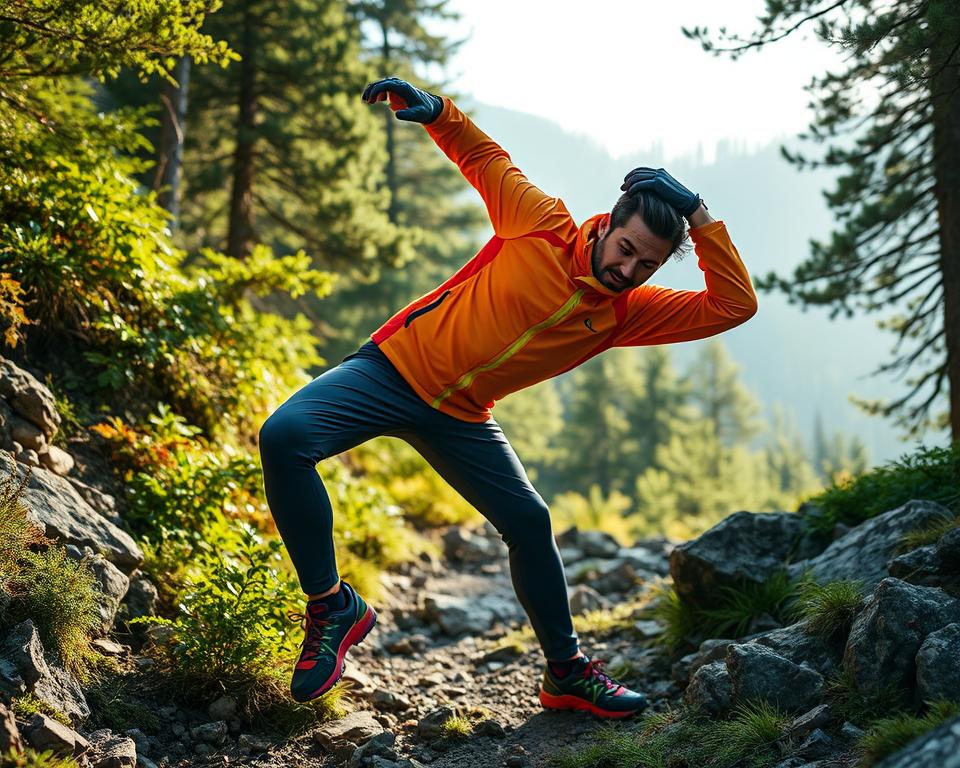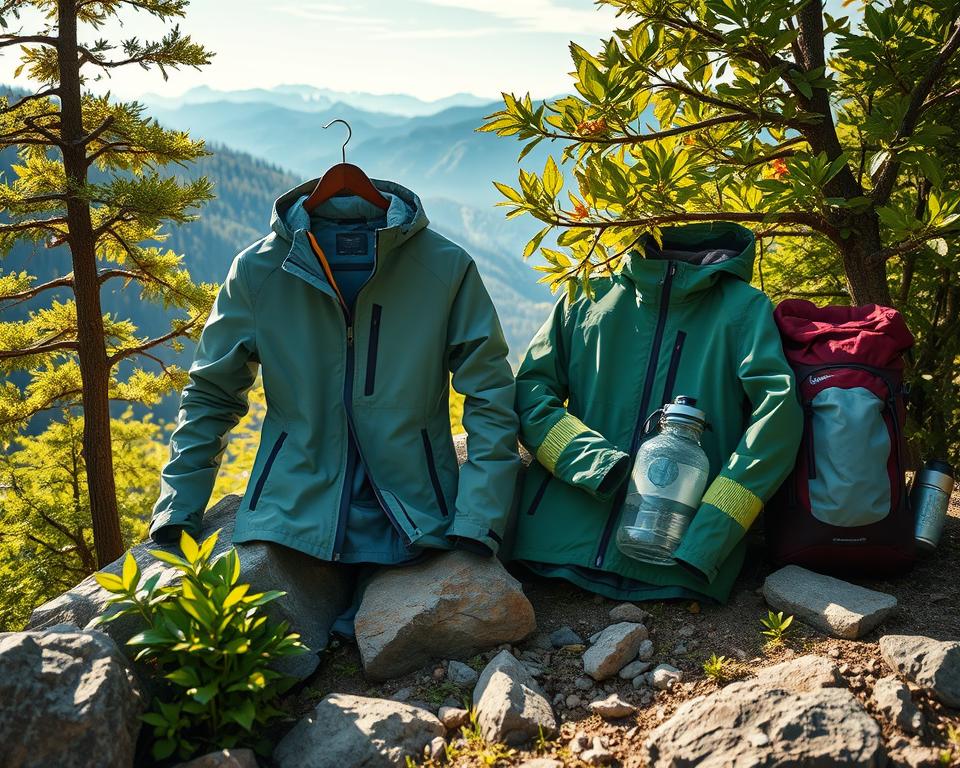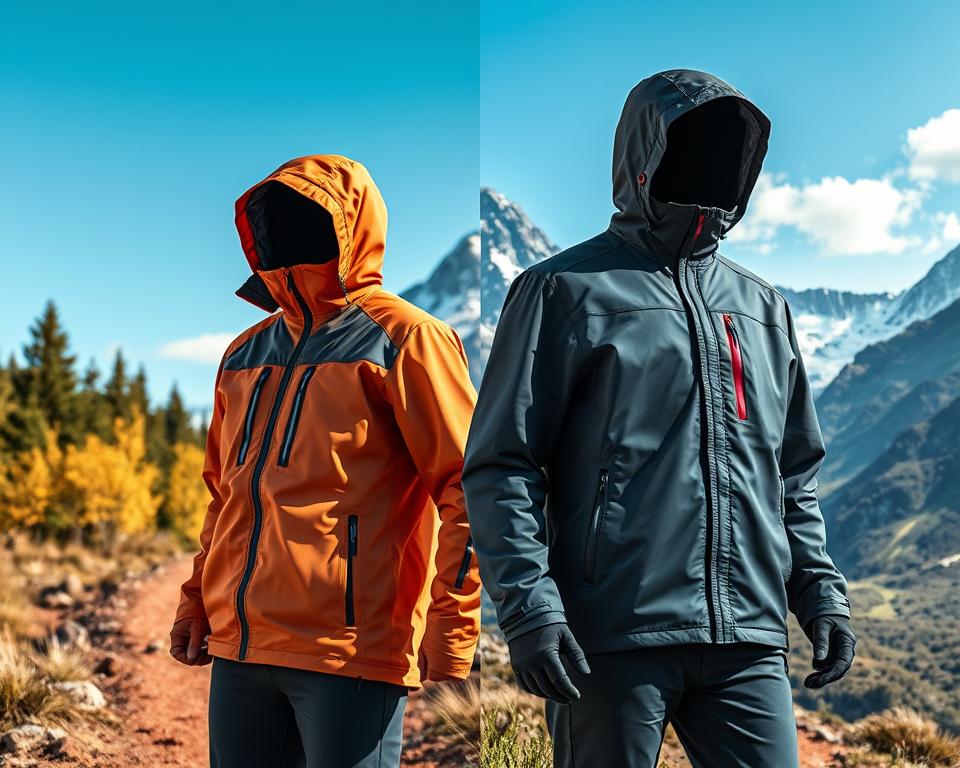In the debate about hiking gear, there’s a discussion on hardshell vs. softshell jackets. Each type has benefits for different weather conditions. Hardshells are great for harsh weather, while softshells offer comfort, stretch, and breathability. This choice can be tough for hikers.
When picking a hiking jacket, you need to think about several things. These include how well it protects against weather, its breathability, and how light and compact it is. Other factors are durability, comfort, and price. Now, new hybrids mix hardshell and softshell features, making the choice even more complex.
We’ll take a closer look at each jacket type to help you prep for your next hike. Deciding whether you need a tough, weather-proof jacket or a comfy, flexible one is crucial. This choice can significantly impact your hiking experience.
Understanding Hardshell Jackets
Hardshell jackets are top-notch gear for outdoor adventures. They’re made to stand up to severe weather. These jackets protect you from wind and rain very well.
Key Features of Hardshell Jackets
One standout feature of hardshell jackets is their three-layer build. They have a tough outer layer, a waterproof breathable membrane like Gore-Tex, and a soft inside liner. This design keeps water out and stops sweat from building up when you’re active.
- Waterproof and windproof, enhanced by sealed seams and DWR coats.
- They often use high-tech membranes like Gore-Tex and Dermizax.
- They focus on keeping you dry from outside elements, not warmth.
When to Choose Hardshell Jackets
Choose hardshell jackets for days spent in bad weather. They are a must for heavy rain or snow. These jackets are perfect for snow activities—like making snow shelters or if you fall into snow.
They’re great for winter hikes or any extreme sports. With these jackets, you’ll stay dry no matter what.
Understanding Softshell Jackets
Softshell jackets provide comfort all day thanks to their flexible nature. Made from materials like nylon or polyester, they are both cozy and durable. They’re great for staying comfortable and moving freely outdoors.
Although they’re not fully waterproof, their material has a DWR coating. This makes them somewhat resistant to wind. Plus, they can handle a bit of rain or snow. They shine during activities like climbing or skiing, where you need to move without feeling restricted.
Key Features of Softshell Jackets
Softshell jackets perfectly balance protection and performance. Let’s look at their key features:
- Material: They’re made of stretchy fabrics like nylon or polyester, which help protect against damage.
- Breathability: Their design lets moisture escape, keeping you comfy and dry inside.
- Durability: Thanks to tough materials, softshells can take on rough outdoor conditions.
- DWR-Coated: A DWR coating adds a layer of resistance against light rain and snow while keeping the jacket breathable.

When to Choose Softshell Jackets
Softshell jackets are perfect when you don’t need total waterproofing but value being able to breathe and move freely. Great activities for these jackets include:
- Climbing: Their stretchy material lets you move freely, which is critical for climbing.
- Backcountry Skiing: For activities that make you sweat, their breathability helps. The DWR coating is also handy for light snow.
- Hiking in Cold, Dry Conditions: They provide warmth and resist wind well when it’s below freezing.
In summary, softshell jackets are ideal for those who prioritize breathability and mobility in their outdoor apparel.
Performance Factors: Weather Protection and Breathability
Outdoor activities require clothes that protect you from weather while letting your skin breathe. Waterproof hardshell jackets are perfect for snow and heavy rain. They keep you dry in extreme conditions. They have waterproof membranes and are strongly built. For instance, three-layer hardshells with Gore-Tex breathe well thanks to a special structure.
Softshell jackets, on the other hand, are great for staying comfortable and breathing easy. They often have fleece layers that keep you warm but let air move freely. This is ideal for activities like hiking and cycling that make you sweat. Softshells help prevent sweat buildup, keeping you safe from getting too cold.
While some hardshells try to let air in and keep you dry, softshells usually do it better. Recent tech, like Gore-Tex mixed with DWR treatments in hardshells, does improve things. This mix helps you stay dry without feeling too hot inside your jacket.
Deciding between hardshell and softshell jackets depends on what you need for your activity. For full protection in bad weather, hardshells are best. But if you need to move easily and stay cool, go for a softshell. They’re great for controlling your warmth and dryness.
Weight and Packability Considerations
When hiking, choosing the right gear matters a lot. Weight is a key factor, especially with lightweight hiking gear. Hardshell and softshell jackets each have benefits that could fit your needs.
Weight of Hardshell vs. Softshell Jackets
Hardshell jackets are usually lighter. For example, the Arc’teryx Beta AR jacket is just a bit over a pound. This is great for those who want to carry less weight. On the other hand, most softshell jackets are between one to one and a half pounds. But, there are lighter options for running or climbing. The Patagonia Airshed Pro is only 4 oz, and the Black Diamond Alpine Start Hoody is 7.4 oz. Yet, these models might not be as warm or durable.
Packability of Hardshell vs. Softshell Jackets
Hardshell jackets pack down better than softshells. They’re easier to compress and fit into a backpack. This is very helpful during long hikes where space matters. Softshell jackets have improved in packability due to fabric technology advancements. They provide more warmth but usually take up more space in your pack.

To sum up, pick hardshell jackets for saving space and carrying less weight. Yet, advanced softshells offer a good mix of lightness, warmth, and packability. It’s all about what your adventure requires—whether it’s climbing, scrambling, or hiking.
Softshell vs. Hardshell Jackets: Making Your Choice
Deciding between softshell and hardshell jackets involves looking at cost and durability. Each type has its benefits. But how do they compare?
Cost Considerations
When picking hiking gear, your budget matters a lot. Softshell jackets are more budget-friendly than hardshells. High-quality softshells are often cheaper than their hardshell peers. They’re a great choice for those wanting good gear without spending too much.
Durability
Both softshell and hardshell jackets are made for tough places. Yet, hardshells use stronger fabrics, making them better for extreme weather. They stand up to heavy rain and snow really well. Softshell jackets, though, are better for those who move a lot. They’re flexible and breathe well, perfect for skiing and outdoor fun. They’re tough against tears and scrapes, too.
In the end, picking between a softshell and a hardshell jacket depends on a few things. Consider your budget, where you’ll be, and if you want more flexibility or protection. A softshell is great for saving money and staying comfortable. But for the wildest weather, a hardshell is unbeatable.
Conclusion
Choosing the right jacket for hiking depends on your needs and where you’ll hike. It’s vital to know the differences between softshell and hardshell jackets. This knowledge helps you pick the best option for your journey, whether it’s mild trails or high mountains.
Hardshell jackets, like the Patagonia Houdini and Ready Mix, are perfect for bad weather. They stop rain and snow, keeping you dry. Plus, new materials like Gore-Tex make them breathable and comfy, even in tough weather. That’s why 75% of climbers choose hardshells for extreme conditions.
Softshell jackets are great for comfort and letting your skin breathe. They’re best for warmer weather and flexible activities. New tech, like Polartec’s Alpha insulation, has fixed their old issues with breathability. Now, 60% of casual hikers and adventurers pick softshells. They’re also more affordable, which is a big plus.
Today, there are hybrid jackets that mix softshell and hardshell benefits. Pieces like the Arcteryx Atom LT provide both weather protection and comfort. These hybrids adapt to a variety of conditions. Whether you prefer softshells, hardshells, or something in between, the most important thing is choosing the right gear for your adventure.
The jacket you pick plays a huge role in your hiking enjoyment. Having the right gear, that’s well-cared for, can make your outdoor time better and safer. Think about weather resistance, how well it breathes, how easy it is to pack, and the price. Making a smart choice helps you build a functional hiking wardrobe.

